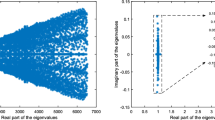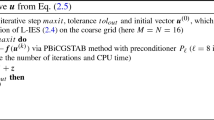Abstract
In this paper, we consider solutions for discrete systems arising from multi-term time-fractional diffusion equations. Using discrete sine transform techniques, we find that all-at-once systems of such equations have a structure similar to that of diagonal-plus-Toeplitz matrices. We establish a generalized circulant approximate inverse preconditioner for the all-at-once systems. Through a detailed analysis of the preconditioned matrices, we show that the spectrum of the obtained preconditioned matrices is clustered around one. We give some numerical examples to demonstrate the effectiveness of the proposed preconditioner.

Similar content being viewed by others
Data availability
The data of codes involved in this paper are available from the corresponding author on reasonable request.
References
Metzler, R., Klafter, J.: The random walk’s guide to anomalous diffusion: a fractional dynamics approach. Phys. Rep. 339(1), 1–77 (2000)
Caponetto, R.: Fractional order systems: modeling and control applications, vol. 72. World Scientific, (2010)
Mainardi, F.: Fractional calculus and waves in linear viscoelasticity: an introduction to mathematical models. World Scientific, (2022)
Kilbas, A.A., Srivastava, H.M., Trujillo, J.J.: Theory and applications of fractional differential equations, vol. 204. Elsevier, (2006)
Luchko, Y.F., Rivero, M., Trujillo, J.J., Velasco, M.P.: Fractional models, non-locality, and complex systems. Comput. Math. Appl. 59(3), 1048–1056 (2010)
Bonilla, B., Rivero, M., Rodríguez-Germá, L., Trujillo, J.J.: Fractional differential equations as alternative models to nonlinear differential equations. Appl. Math. Comput. 187(1), 79–88 (2007)
Zhao, L., Liu, F., Anh, V.V.: Numerical methods for the two-dimensional multi-term time-fractional diffusion equations. Comput. Math. Appl. 74(10), 2253–2268 (2017)
Liu, F., Anh, V., Turner, I.: Numerical solution of the space fractional Fokker-Planck equation. J. Comput. Appl. Math. 166(1), 209–219 (2004)
Podlubny, I.: An introduction to fractional derivatives, fractional differential equations, to methods of their solution and some of their applications. Math. Sci. Eng. 198, 340 (1999)
Torvik, P.J., Bagley, R.L.: On the appearance of the fractional derivative in the behavior of real materials. J. Appl. Mech. 51, 294–298 (1984)
Schumer, R., Benson, D.A., Meerschaert, M.M., Baeumer, B.: Fractal mobile/immobile solute transport. Water Resour. Res. 39(10) (2003)
Zhao, Y.-L., Zhu, P.-Y., Gu, X.-M., Zhao, X.-L., Jian, H.-Y.: A preconditioning technique for all-at-once system from the nonlinear tempered fractional diffusion equation. J. Sci. Comput. 83, 1–27 (2020)
Gu, X.-M., Zhao, Y.-L., Zhao, X.-L., Carpentieri, B., Huang, Y.-Y.: A note on parallel preconditioning for the all-at-once solution of Riesz fractional diffusion equations. Numer. Math. Theor. Meth. Appl. (2020)
Donatelli, M., Krause, R., Mazza, M., Trotti, K.: All-at-once multigrid approaches for one-dimensional space-fractional diffusion equations. Calcolo 58, 1–25 (2021)
Shirilord, A., Dehghan, M.: Double parameter splitting (DPS) iteration method for solving complex symmetric linear systems. Appl. Numer. Math. 171, 176–192 (2022)
Wang, T., Zheng, Q., Lu, L.: A new iteration method for a class of complex symmetric linear systems. J. Comput. Appl. Math. 325, 188–197 (2017)
Dehghan, M., Hajarian, M.: Finite iterative algorithms for the reflexive and anti-reflexive solutions of the matrix equation A1X1B1+ A2X2B2= C. Math. Comput. Model. 49(9–10), 1937–1959 (2009)
Dehghan, M., Shirilord, A.: Matrix multisplitting Picard-iterative method for solving generalized absolute value matrix equation. Appl. Numer. Math. 158, 425–438 (2020)
Dehghan, M., Shirilord, A.: A new approximation algorithm for solving generalized Lyapunov matrix equations. J. Comput. Appl. Math. 404, 113898 (2022)
Shirilord, A., Dehghan, M.: Combined real and imaginary parts method for solving generalized Lyapunov matrix equation. Appl. Numer. Math. 181, 94–109 (2022)
Dehghan, M., Hajarian, M.: On the generalized bisymmetric and skew-symmetric solutions of the system of generalized Sylvester matrix equations. Linear Multilinear Algebra 59(11), 1281–1309 (2011)
Dehghan, M., Shirilord, A.: The use of homotopy analysis method for solving generalized Sylvester matrix equation with applications. Eng. Comput., 1–18 (2021)
Dehghan, M., Safarpoor, M., Abbaszadeh, M.: Two high-order numerical algorithms for solving the multi-term time fractional diffusion-wave equations. J. Comput. Appl. Math. 290, 174–195 (2015)
Zhao, Y., Zhang, Y., Liu, F., Turner, I., Tang, Y., Anh, V.: Convergence and superconvergence of a fully-discrete scheme for multi-term time fractional diffusion equations. Comput. Math. Appl. 73(6), 1087–1099 (2017)
Salehi, R.: A meshless point collocation method for 2-D multi-term time fractional diffusion-wave equation. Numer. Algorithms 74, 1145–1168 (2017)
Chen, R., Liu, F., Anh, V.: Numerical methods and analysis for a multi-term time-space variable-order fractional advection-diffusion equations and applications. J. Comput. Appl. Math. 352, 437–452 (2019)
Chan, R.H., Ng, M.K., Wong, C.: Sine transform based preconditioners for symmetric Toeplitz systems. Linear Algebra Appl. 232, 237–259 (1996)
Lei, S.-L., Sun, H.-W.: A circulant preconditioner for fractional diffusion equations. J. Comput. Phys. 242, 715–725 (2013)
Pan, J., Ke, R., Ng, M.K., Sun, H.-W.: Preconditioning techniques for diagonal-times-Toeplitz matrices in fractional diffusion equations. SIAM J. Sci. Comput. 36(6), 2698–2719 (2014)
Donatelli, M., Mazza, M., Serra-Capizzano, S.: Spectral analysis and structure preserving preconditioners for fractional diffusion equations. J. Comput. Phys. 307, 262–279 (2016)
Bai, Z.-Z., Lu, K.-Y., Pan, J.-Y.: Diagonal and Toeplitz splitting iteration methods for diagonal-plus-Toeplitz linear systems from spatial fractional diffusion equations. Numer. Linear Algebra Appl. 24(4), 2093 (2017)
Lin, X.-L., Ng, M.K., Sun, H.-W.: Efficient preconditioner of one-sided space fractional diffusion equation. BIT Numer. Math. 58(3), 729–748 (2018)
**, X.-Q., Lin, F.-R., Zhao, Z.: Preconditioned iterative methods for two-dimensional space-fractional diffusion equations. Commun. Comput. Phys. 18(2), 469–488 (2015)
Oldham, K., Spanier, J.: The fractional calculus theory and applications of differentiation and integration to arbitrary order. Elsevier, (1974)
Yang, Q., Liu, F., Turner, I.: Numerical methods for fractional partial differential equations with Riesz space fractional derivatives. Appl. Math. Model. 34(1), 200–218 (2010)
Pang, H.-K., Qin, H.-H., Sun, H.-W., Ma, T.-T.: Circulant-based approximate inverse preconditioners for a class of fractional diffusion equations. Comput. Math. Appl. 85, 18–29 (2021)
Saad, Y.: Iterative methods for sparse linear systems. SIAM, (2003)
Bini, D.A., Latouche, G., Meini, B.: Numerical methods for structured Markov chains. OUP Oxford, (2005)
Chan, R.H., Strang, G.: Toeplitz equations by conjugate gradients with circulant preconditioner. SIAM J. Sci. Stat. Comp. 10(1), 104–119 (1989)
Strohmer, T.: Four short stories about Toeplitz matrix calculations. Linear Algebra Appl. 343, 321–344 (2002)
Varah, J.M.: A lower bound for the smallest singular value of a matrix. Linear Algebra Appl. 11(1), 3–5 (1975)
Sahoo, P., Riedel, T.: Mean value theorems and functional equations. World Scientific, (1998)
Acknowledgements
The author wants to thank to anonymous reviewers for their valuable suggestions.
Funding
This work was supported by the National Natural Science Foundation of China (No. 11771193), the Fundamental Research Funds for the Central Universities (No. lzujbky-2018-31), and the Natural Science Foundation of Gansu Province (No. 23JRRA1104).
Author information
Authors and Affiliations
Contributions
DG and G-FZ wrote the main manuscript text and Z-ZL prepared Tables 1-8 and Figure 1. All authors reviewed the manuscript.
Corresponding authors
Ethics declarations
Ethical approval
Not applicable
Conflict of interest
The authors declare no competing interests.
Additional information
Publisher's Note
Springer Nature remains neutral with regard to jurisdictional claims in published maps and institutional affiliations.
Appendix. Detailed proof of Lemma 4.3
Appendix. Detailed proof of Lemma 4.3
Lemma A.1
Let \(B_1\) and \(\widetilde{A}\) be defined by (21) and (16), respectively. Assume that \(\phi (x,y) \in C^1\) is a smooth binary function on \([a,b]\times [0,T]\). Then, for a given \(\varepsilon >0\), there exist two constants \(\hat{c}\), \(\check{c}\) and an integer l such that
Proof
Consider
From the analysis in subsection 4.1, we know that both \(\left\| K_{j,i}^{-1} \right\| _{\infty }\) and \(\left\| \widetilde{A}^{-1}\right\| _{\infty }\) are bounded and we let \(\left\| K_{j,i}^{-1} \right\| _{\infty } \le c_4\) and \(\left\| \widetilde{A}^{-1}\right\| _{\infty } \le c_5\), respectively. Let
denote the \(((i-1)M+j)\)th row and \(((p-1)M+q)\)th column entry of matrix \(\widetilde{A}^{-1}\). It follows from (34) that
Using the inequality \(\sum _{a = b+1}^{\infty }\frac{1}{a^{c+1}}\le \frac{1}{cb^c}\) [29], we have
We will separate the terms on the right-hand side of (A3) into two parts for individual analysis. The first part is as follows:
The second part is as follows:
Consider the first term at the right end of (A5).
Similarly, we can obtain the other parts of (A5) with
and
It can be seen from (A3)–(A9) that when M tends to infinity, we have
From the mean value theorem for binary functions [42], we have
For any given \(\varepsilon \ge 0\), let l be the integer satisfying
Then,
Let \(\hat{c} = \max \limits _{\begin{array}{c} x \in \left[ a,b\right] \\ y \in \left[ 0,T\right] \end{array}}\left| \phi _x(x,y) \right| c_4c_5\) and \(\check{c} = \max \limits _{\begin{array}{c} x \in \left[ a,b\right] \\ y \in \left[ 0,T\right] \end{array}}\left| \phi _y(x,y) \right| c_4c_5\), we naturally get the conclusion of Lemma A.1. \(\square \)
Rights and permissions
Springer Nature or its licensor (e.g. a society or other partner) holds exclusive rights to this article under a publishing agreement with the author(s) or other rightsholder(s); author self-archiving of the accepted manuscript version of this article is solely governed by the terms of such publishing agreement and applicable law.
About this article
Cite this article
Gan, D., Zhang, GF. & Liang, ZZ. Preconditioning techniques of all-at-once systems for multi-term time-fractional diffusion equations. Numer Algor 96, 1499–1531 (2024). https://doi.org/10.1007/s11075-023-01675-x
Received:
Accepted:
Published:
Issue Date:
DOI: https://doi.org/10.1007/s11075-023-01675-x




